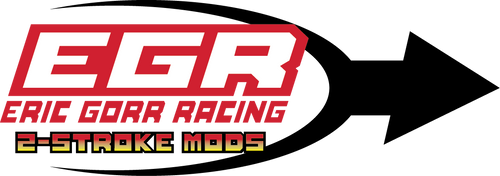Eric Gorr's Online Store.
EGR SHIFTING FROM MACHINE SERVICES TO BIG BORE PARTS
- NEW SHOPIFY SITE FOR WORLDWIDE MAIL-ORDER FULFILLMENT OF BIG BORE PARTS
- BIG BORE PISTONS 134,144,265, 295, 330, 525 EGR, WISECO, WOSSNER, VERTEX, MAGNUM
- COMETIC MLS BIG BORE HEAD GASKETS CR & KX MODELS
- EGR BIG BORE YZ CYLINDERS AND HEAD AND POWERVALVES
- MANY NEW PRODUCTS IN THE SUPPLY CHAIN FOR CHRISTMAS 2024
SHOPIFY SITE OPENING SOON ON THIS WEBSITE! STAY TUNED
MACHINE AND REPAIR SERVICES
I retired from machine work at Christmas so we no longer accept packages from people intended for in-bound mail-order service. We have 200 finished ported plated cylinders for fast trade-up but you have to call to reserve and pay. Call Eric at 1-630-825-5645 to check availability for your make and model bike.
6 DAYS 12 HOUR TELEPHONE TECH SERVICE ENDING SOON!
Once my Shopify site is open I Eric will only answer tech questions y text or email. Otherwise there will be a page on the Shopify site to pre-pay for live telephone tech questions.
GARAGE SALE
I'm selling out all the abandoned cylinders and engines left over from deadbeat customers. Right now I'm putting together a list to post on my new Shopify site that includes hundreds of items from my 53 year career as a race mechanic in the sport of motocross, including memorabilia from the 1970s-90s.
NEW PRODUCTS IN THE PIPELINE
I designed a range of products to be released this year, here's a snapshot of what just became available and what's in the supply chain headed for market.
YZ? Why Me? If you have a Yamaha YZ125 2005 or newer or a YZ250 1999 and newer we have replacement parts like 125,134,144,250, & 295cc cylinders, cylinder heads, and powervalves for the 250,295.
The 2022 and newer YZ125 has a different cylinder that Athena and Cylinder Works do NOT make a 144 kit, and the MAGNUM brand will be the first to offer a reliable 144 off-road top end assembly with my original design. This kit features a special cylinder with strong bridges to reduce wear and seizures. The cylinder uses the new Wossner 2-ring 12-degree race piston for maximum engine hours. The porting and head mods are designed to work with the custom powervalves for a smooth broad powerband that is dominant over the standard KTM150.
NSR HONDA IS BACK!
All throughout the 1980s I worked for a Honda motorcycle dealer in Chicago and built a custom Honda CR business. Our Honda CRs raced in outdoor nationals and the Moto GPs of Europe competing head to head with our rivals the HRC Hondas. Now I'm bringing it back with some special new products for Honda CR 2-strokes.
Universal 144 is a top end kit that converts a 125 to a 144 with an all inclusive top end assembly that fits a wide range of model years including 1987-2002 CR125. This modern plated 144 includes the cylinder, head, exhaust manifold, piston and gasket kits, and the best part is I eliminated the powervalves. That stupid contraption that often breaks and seizes the cylinder. These cylinders have the proper porting so they don't need unreliable powervalves.
I NEED MORE! That's what guys riding CR500s say. So I made a cylinder with my Mo-Betta porting, no iron sleeve. My design is a cast aluminum cylinder with plating from Millennium. The whole deal is made by us Cheeseheads in Wisconsin USA. I designed a cylinder that ranges from the stock 89mm (490cc) to 93mm (516cc) so a 26cc range. The ports are designed to allow modification so it can be tuned for technical mountain climbing to WFO dunes or even a winged dirt kart, and its designed to accept the new 2-4mm stroker crankshafts available from BUILT 500.
STAY TUNED!
ERIC GORR
